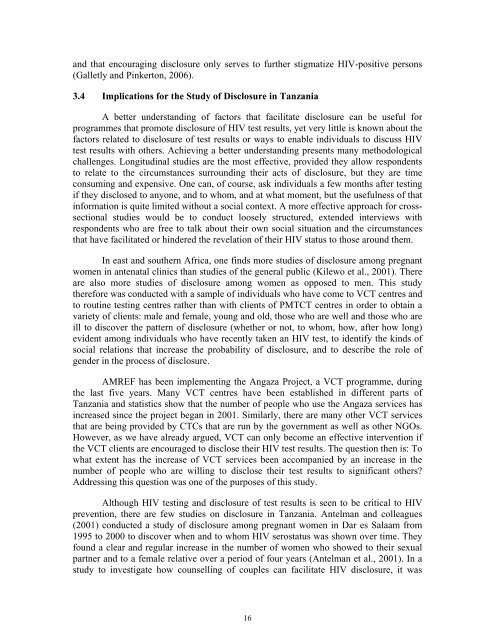social context of disclosing hiv test results: hiv testing in tanzania
social context of disclosing hiv test results: hiv testing in tanzania
social context of disclosing hiv test results: hiv testing in tanzania
Create successful ePaper yourself
Turn your PDF publications into a flip-book with our unique Google optimized e-Paper software.
and that encourag<strong>in</strong>g disclosure only serves to further stigmatize HIV-positive persons<br />
(Galletly and P<strong>in</strong>kerton, 2006).<br />
3.4 Implications for the Study <strong>of</strong> Disclosure <strong>in</strong> Tanzania<br />
A better understand<strong>in</strong>g <strong>of</strong> factors that facilitate disclosure can be useful for<br />
programmes that promote disclosure <strong>of</strong> HIV <strong>test</strong> <strong>results</strong>, yet very little is known about the<br />
factors related to disclosure <strong>of</strong> <strong>test</strong> <strong>results</strong> or ways to enable <strong>in</strong>dividuals to discuss HIV<br />
<strong>test</strong> <strong>results</strong> with others. Achiev<strong>in</strong>g a better understand<strong>in</strong>g presents many methodological<br />
challenges. Longitud<strong>in</strong>al studies are the most effective, provided they allow respondents<br />
to relate to the circumstances surround<strong>in</strong>g their acts <strong>of</strong> disclosure, but they are time<br />
consum<strong>in</strong>g and expensive. One can, <strong>of</strong> course, ask <strong>in</strong>dividuals a few months after <strong>test</strong><strong>in</strong>g<br />
if they disclosed to anyone, and to whom, and at what moment, but the usefulness <strong>of</strong> that<br />
<strong>in</strong>formation is quite limited without a <strong>social</strong> <strong>context</strong>. A more effective approach for crosssectional<br />
studies would be to conduct loosely structured, extended <strong>in</strong>terviews with<br />
respondents who are free to talk about their own <strong>social</strong> situation and the circumstances<br />
that have facilitated or h<strong>in</strong>dered the revelation <strong>of</strong> their HIV status to those around them.<br />
In east and southern Africa, one f<strong>in</strong>ds more studies <strong>of</strong> disclosure among pregnant<br />
women <strong>in</strong> antenatal cl<strong>in</strong>ics than studies <strong>of</strong> the general public (Kilewo et al., 2001). There<br />
are also more studies <strong>of</strong> disclosure among women as opposed to men. This study<br />
therefore was conducted with a sample <strong>of</strong> <strong>in</strong>dividuals who have come to VCT centres and<br />
to rout<strong>in</strong>e <strong>test</strong><strong>in</strong>g centres rather than with clients <strong>of</strong> PMTCT centres <strong>in</strong> order to obta<strong>in</strong> a<br />
variety <strong>of</strong> clients: male and female, young and old, those who are well and those who are<br />
ill to discover the pattern <strong>of</strong> disclosure (whether or not, to whom, how, after how long)<br />
evident among <strong>in</strong>dividuals who have recently taken an HIV <strong>test</strong>, to identify the k<strong>in</strong>ds <strong>of</strong><br />
<strong>social</strong> relations that <strong>in</strong>crease the probability <strong>of</strong> disclosure, and to describe the role <strong>of</strong><br />
gender <strong>in</strong> the process <strong>of</strong> disclosure.<br />
AMREF has been implement<strong>in</strong>g the Angaza Project, a VCT programme, dur<strong>in</strong>g<br />
the last five years. Many VCT centres have been established <strong>in</strong> different parts <strong>of</strong><br />
Tanzania and statistics show that the number <strong>of</strong> people who use the Angaza services has<br />
<strong>in</strong>creased s<strong>in</strong>ce the project began <strong>in</strong> 2001. Similarly, there are many other VCT services<br />
that are be<strong>in</strong>g provided by CTCs that are run by the government as well as other NGOs.<br />
However, as we have already argued, VCT can only become an effective <strong>in</strong>tervention if<br />
the VCT clients are encouraged to disclose their HIV <strong>test</strong> <strong>results</strong>. The question then is: To<br />
what extent has the <strong>in</strong>crease <strong>of</strong> VCT services been accompanied by an <strong>in</strong>crease <strong>in</strong> the<br />
number <strong>of</strong> people who are will<strong>in</strong>g to disclose their <strong>test</strong> <strong>results</strong> to significant others?<br />
Address<strong>in</strong>g this question was one <strong>of</strong> the purposes <strong>of</strong> this study.<br />
Although HIV <strong>test</strong><strong>in</strong>g and disclosure <strong>of</strong> <strong>test</strong> <strong>results</strong> is seen to be critical to HIV<br />
prevention, there are few studies on disclosure <strong>in</strong> Tanzania. Antelman and colleagues<br />
(2001) conducted a study <strong>of</strong> disclosure among pregnant women <strong>in</strong> Dar es Salaam from<br />
1995 to 2000 to discover when and to whom HIV serostatus was shown over time. They<br />
found a clear and regular <strong>in</strong>crease <strong>in</strong> the number <strong>of</strong> women who showed to their sexual<br />
partner and to a female relative over a period <strong>of</strong> four years (Antelman et al., 2001). In a<br />
study to <strong>in</strong>vestigate how counsell<strong>in</strong>g <strong>of</strong> couples can facilitate HIV disclosure, it was<br />
16

















